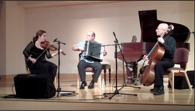Music from the Carpathian Bow

The Klezmer Shul

The Klezmer Shul, the latest work of Veretski Pass, is a four movement suite that attempts to bridge the gap between the sacred and the secular, not through the use of words, but with purely instrumental music.
In the 1000 year history of Ashkenazic culture, research has shown that there were Jewish trade guilds, which often established their own small
synagogues, or shuls. There were shuls for tailors, shoemakers, stone cutters — and klezmorim (musicians). Inspired by these historic accounts, Stu Brotman obtained a grant from the Creative Work Fund in San Francisco for Veretski Pass to compose a klezmer-based, musical impression of a Jewish service.
Were these shuls, also known as kloyzn or shtiblekh, places for traditional services, or were they also meeting halls, gathering places for all-night jam sessions with visiting musicians and musical neighbors? In The Klezmer Shul, Cookie, Josh, and Stu reimagine them as centers of multi-cultural music making, where musicians could inspire each other, improvising, recombining, mixing the melodies of the service with local Folk, Classical and popular music.

The Klezmer Shul is a tone poem in four movements with a total of twenty-three discrete segments and includes structural elements of the classical sonata, traditional klezmer dance suites, and free jazz. Our original impulse in creating this work was to give the listener an emotional experience comparable to attending a religious service. In reinterpreting the traditional Jewish liturgy, we drew from the musical vocabularies of the many peoples among whom klezmer musicians have lived and worked.
This creates an ecumenical atmosphere of inclusion amidst confusion. The disparate cultural musical references may be familiar, but the listener can’t quite place the associations; isolated elements are recognizable, but the properties of melodic and harmonic cohesion are not in the expected patterns.
The practice of recycling music is not specific to this project; it’s an integral, perhaps inescapable, aspect of musical composition. The transformation of melodies of other cultures is a common principle in the composition of Hasidic nigunim (wordless prayer melodies). As in gospel music, it is considered a holy act to borrow secular melodies in the service of worship, relying on music’s emotive power to transport listeners into a receptive state.
Antiphony—the technique of call and response—is perhaps the single most identifiable gesture of spiritual dramaturgy and is common to many religions. We discovered so many variants of antiphony that we wanted to use the idea as a kind of ritornello — a recurring theme or group of themes — throughout the work. Compositional techniques we used include pantonality, beat displacement, free improvisation, and programmatic devices such as instrumental impressions of the noise and clatter in a synagogue.
The Music
“For musical inspiration, our sources ranged from the traditional melodies of the synagogue to the folk music of the many peoples among whom Jews lived and worked: Rom (Gypsy), Ukrainian, Hungarian, Romanian, Moldavian, Czech, Polish melodies. Employing techniques of modern Classical composition, modern Jazz, and even Gospel music styles, we felt it important to leave the structure of the arrangements open in order to allow room for improvisation, which generates the core of our work. In this way each performance is spontaneous and unique.”
The Klezmer Shul is intended as a spiritual experience, as well as pure concert music. Veretski Pass offers it as a gesture of reconciliation in a world divided by doctrine, and dedicates it to the memory of musicians lost to war.
Download Flyer
The Klezmer Shul
East Bay Premieres
Download Flyer
The Klezmer Shul
Palo Alto Premiere
Download PRESS RELEASE
The Klezmer Shul
East Bay Premieres
Leonard Levy - Director & Editor
Camera - Eli Adler, Rob Weiner, Saul Rouda, Todd Keitz, Shaun
Although we enjoyed mixing traditional with more experimental techniques, our decisions were always based on aesthetic principles of energy, timbre, contour, and texture.
See the schedule for more information and to download the fliers and press release for the CA premieres, or email us by here: Klezmer Shul Info


